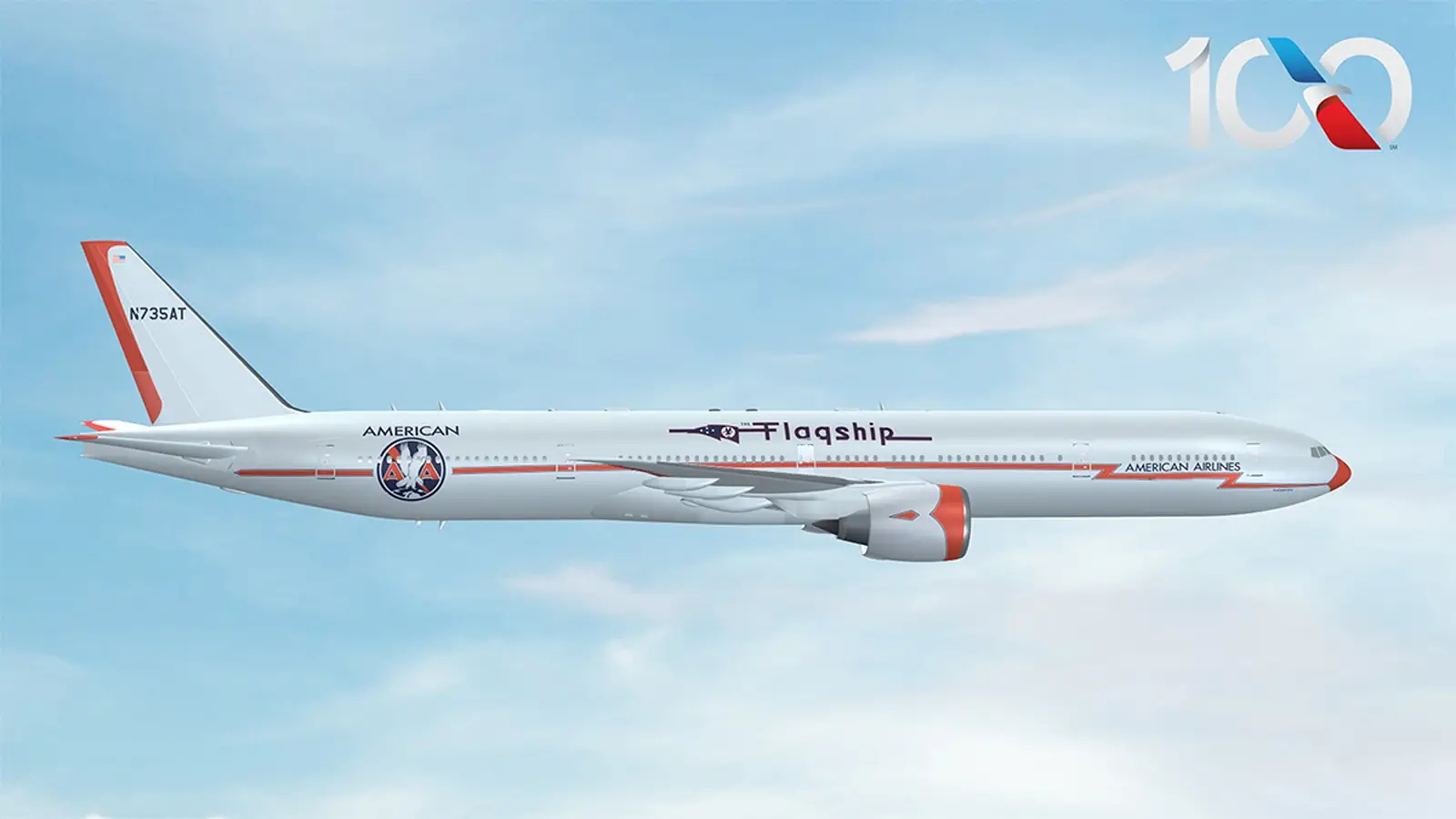Copyright Simple Flying

American Airlines has decided to return to its roots, applying an iconic livery, inspired by its first Douglas DC-3 from 1936, to mark the airline's 100-year history. The livery celebrates the airline's rich history and memorializes its original 'flagship' logo by applying it to the aircraft best-suited to bear such a title, the Boeing 777-300ER. The design itself instantly invokes emotion and memories for aviation enthusiasts and travelers, reimagining the polished metallic finish and classic logos that once defined American’s identity for decades. What inspired this nostalgic design? How does it connect to the airline’s heritage, and why do such liveries continue to capture the imagination of travelers around the world? Entering its centenary, American Airlines has become a major figure in the history of commercial aviation, from its early Douglas DC-3s to the modern widebody jets that connect America to the world today. While the airline’s branding has changed many times, few images remain as iconic as the gleaming silver fuselages that once dominated US skies. With its new retro-themed Boeing 777-300ER, American pays tribute to this legacy, honoring the past but with a modern take. The result is more than just a standout design; it’s a reflection of how an airline honors its past on the outside while focusing on the future for the inside. Silver Is Back In Fashion Few airlines have maintained such a distinctive visual identity throughout aviation history as American Airlines. It all began in the 1930s when aircraft gleamed with unpainted, polished aluminum. Something that, in modern times, is nearly unheard of, but during its early days, the livery was a bold statement of modernity and efficiency that set it apart from competitors. The look became synonymous with American’s brand ever since, symbolizing speed, innovation, and pride in US aviation. In today's era, the shine has been replaced by a much tamer silver color, but the new retro livery reawakens that spirit, reminding passengers and aviation enthusiasts alike of an era when the silver bird defined the American skies. The original polished metal finish, first introduced in the pre-jet age, became a focal part of the airline’s DNA. Technological optimism was at an all-time high during the mid-20th century, and American carried this within its identity. Besides this, it was also a functional advantage for the airline. Lighter aircraft and reduced fuel costs, but unfortunately, when the airline’s fleet transitioned to composite materials in the 2000s, the bare-metal aesthetic became impossible to maintain. This led to the 2013 rebrand featuring a sleek gray and red design. For many, the classic look never lost its emotional resonance, and there has always been somewhat of a desire for many for a return to American's original identity. American’s decision to revive this design on a Boeing 777-300ER is both nostalgic and symbolic. The polished metal is once again returning to the skies, recreated with modern paint techniques. It reminds us of icons such as the McDonnell Douglas DC-10, McDonnell Douglas MD-80, and Boeing 727 that once carried millions of travelers across the country. In a single aircraft, American Airlines has bridged generations, connecting the pioneering spirit of its past with the cutting-edge technology of its present fleet. What Inspired The Retro Look Bringing the spirit of American Airlines’ heritage into the modern era was no easy task. The concept for the 777-300ER’s retro livery was born from a desire to honor the airline’s legacy while ensuring the design met today’s technical and aesthetic standards. American’s internal brand team, working alongside aviation design specialists, set out to recreate the look that once defined its fleet, but on a far larger and more complex canvas. The special design, which will debut in November 2025 on a Boeing 777-300ER registered N735AT, reimagines one of the airline’s earliest liveries for the jet age. Officially named “Flagship DFW,” the aircraft pays homage to American’s home base and long tradition of premium travel. Designers reintroduced the bright red lightning bolt, which first appeared nearly 90 years ago, slicing boldly across a shimmering 'Silver Eagle' fuselage. Toward the rear of the aircraft, the iconic eagle roundel has returned, symbolizing American’s global reach and heritage of connecting the world. Under the cockpit windows, the words “American Airlines” are printed in a simple, modern sans-serif font, while the term “Flagship” has been applied to the upper mid-fuselage, a respectful nod to the airline’s earliest leading aircraft. According to Ron DeFeo, American’s Chief Communications Officer, the project symbolizes both reflection and renewal: “American has thoughtfully chosen a design that evokes our rich history while looking ahead to our next 100 years. Painting the original flagship design on our flagship aircraft is a powerful way to honor that legacy while embracing the future.” The livery’s debut helpfully aligns with American’s plan to refresh its Boeing 777-300ER interiors next year. The latest update brings with it Flagship Suite seats, upgraded Premium Economy, and new Main Cabin features, all designed to reignite the 'Flagship' name and its elegance. By pairing a vintage aesthetic with a modern flagship aircraft, American has combined two contrasting design choices into a result that feels well polished and well paired. Why Bring Back A Classic? Retro liveries have become one of aviation’s most powerful and captivating storytelling tools, and American Airlines’ centennial design proves just how deeply nostalgia resonates with travelers. For passengers, these heritage schemes are emotional connections to an era when air travel represented glamour, innovation, and national pride. In a time when most airlines strive for sleek minimalism, the reintroduction of a retro logo reminds travelers of aviation’s human side, the people, milestones, and memories that built the modern flying experience. It serves as a reminder of what came before, highlighting the industry's progression. American’s centennial Flagship livery joins a growing trend among many legacy carriers celebrating historic milestones through retro designs. Earlier this year, for example, Delta Air Lines unveiled its own 100-year livery on an Airbus A321neo, representing the airline’s 1925 founding and its evolution from a crop-dusting operation to a global carrier. Meanwhile, over in Europe, Lufthansa plans to debut its centennial-themed Boeing 787-9 in December 2025, incorporating design elements that trace back to its earliest aircraft but with a much more modern aesthetic. By reviving their classic branding, these airlines tap into nostalgia that resonates across generations and appeals equally to aviation enthusiasts and casual travelers alike. For airlines, heritage liveries serve both branding and community purposes. They rekindle emotional loyalty among longtime customers while sparking excitement across social media, especially among younger generations discovering the art and history of flight. These liveries are always eye-catching and stick in the memory of anyone lucky enough to see them. In American’s case, the centennial livery focuses on a broader initiative to unite past and present. It celebrates the pioneering DC-3 that launched its Flagship legacy while showcasing the ultra-modern 777-300ER, highlighting American's commitment to a synergy of heritage and a future focus. The Latest Flagship American Airlines’ decision to feature its centennial Flagship livery on the Boeing 777-300ER is both strategic and symbolic. As the airline’s largest and most prestigious aircraft, the 777-300ER headlines its long-haul international network, serving destinations from Dallas–Fort Worth to London, Tokyo, and Sydney, to name a few. By selecting this aircraft as the canvas for its heritage design, American somewhat officially recognizes its flagship status and proves to the world that it is the perfect ambassador for a century of flight. Beyond its striking new exterior, the aircraft also marks the beginning of a major interior overhaul that will redefine American’s premium travel experience. Starting in 2026, the airline will introduce its next-generation Flagship Suite seats aboard the 777-300ER, which is the same product that debuted on its newly delivered Boeing 787-9s earlier this year. These business class suites feature privacy doors, wireless charging pads, and a chaise-lounge seating option, offering travelers the most elevated onboard experience on an American Airlines service to date. The upgrade will also include an expanded Premium Economy cabin, the first in the US to feature wireless charging, along with an improved headrest design and leg support for enhanced comfort, further adding to a long list of major changes that will mark the next chapter for the flag carrier. These changes align perfectly with the centennial livery’s message and honor tradition while embracing innovation. The “Flagship DFW” aircraft will be a showcase of American's future and what is in store for the foreseeable future, a future that is firmly rooted in tradition. As Ron DeFeo, Chief Communications Officer, emphasized, the Flagship livery represents a renewed focus on premium travel “across all aspects of our customers’ journeys". It remains to be seen whether this decision will be continued far into the future, but what is certain is that a lot of change is set to come to American Airlines. What Has Been The Response? Aviation is far more than just technology and timetables; memory, identity, and emotion fuel everything that we see in the industry. As for the debut of this new heritage livery, it instantly struck a chord with travelers of all ages. For those who remember the airline’s polished-metal jets and early Flagship Service, the design brings back fond memories of a golden age of travel. For younger generations, it offers a tangible link to aviation history, a way to experience the legacy of American’s first Douglas DC-3s through the lens of a modern widebody aircraft, and preserve the memory of what once was American Airlines. The excitement surrounding the new Boeing 777-300ER’s retro look has spread rapidly across aviation communities and social media platforms. Photos of the gleaming Silver Eagle fuselage and bold lightning bolt motif have drawn thousands of likes and shares from fans and frequent flyers alike, as well as widespread discussion about the livery. Aviation enthusiasts have praised the livery for its authenticity and attention to detail despite challenges in being able to replicate the 'bare metal' color, while casual travelers admire its elegance and storytelling value. The reveal event at Dallas–Fort Worth International Airport, complete with American Airlines crew members and company historians, showcased the pride employees take in seeing their heritage revived in such a dramatic way. In many ways, this livery represents the bridge between American Airlines’ first passengers and today’s global flyers. The “Flagship” name, which was once used to distinguish transcontinental luxury service, now embodies a century of progress. From the mail-carrying days of Charles Lindbergh’s 1926 flights with Robertson Aircraft Corporation to the 21st-century Flagship Suite, the airline’s story has come full circle. A Dawn Of A New Era As American Airlines approaches its official centennial in 2026, the new Flagship livery is just the beginning of a larger story. The airline has hinted that the Boeing 777-300ER’s design may inspire additional projects celebrating key milestones from its first century of flight. Whether through more heritage liveries, museum partnerships, or special centennial events, it remains to be seen. But what is evidently clear is that American is positioning its brand to honor a past that continues to define its future. The success of this project also reflects a growing appetite among travelers for aviation storytelling. The ability to showcase experiences that extend beyond the cabin and into the cultural identity of flight itself. American’s centennial initiative combines this storytelling with tangible innovation, bringing a refreshed flagship fleet complete with elevated onboard products and a commitment to premium service that echoes the “Flagship” tradition of the 1930s. The airline’s move to celebrate heritage through design not only differentiates it from competitors but also strengthens its emotional bond with both customers and employees alike. Looking ahead, American’s centennial year promises to be the start of something much bigger than just a livery. From the “Flagship DFW” Boeing 777-300ER to the centennial-branded merchandise and historic imagery now featured in the airline’s Brand Store, every detail serves as a reminder that legacy and innovation can coexist. As American Airlines takes flight into its next hundred years, its special livery stands as both a tribute to the pioneers who built it and most importantly, a promise to the generations who will continue to fly under its wings.



